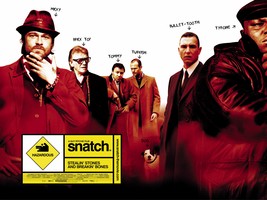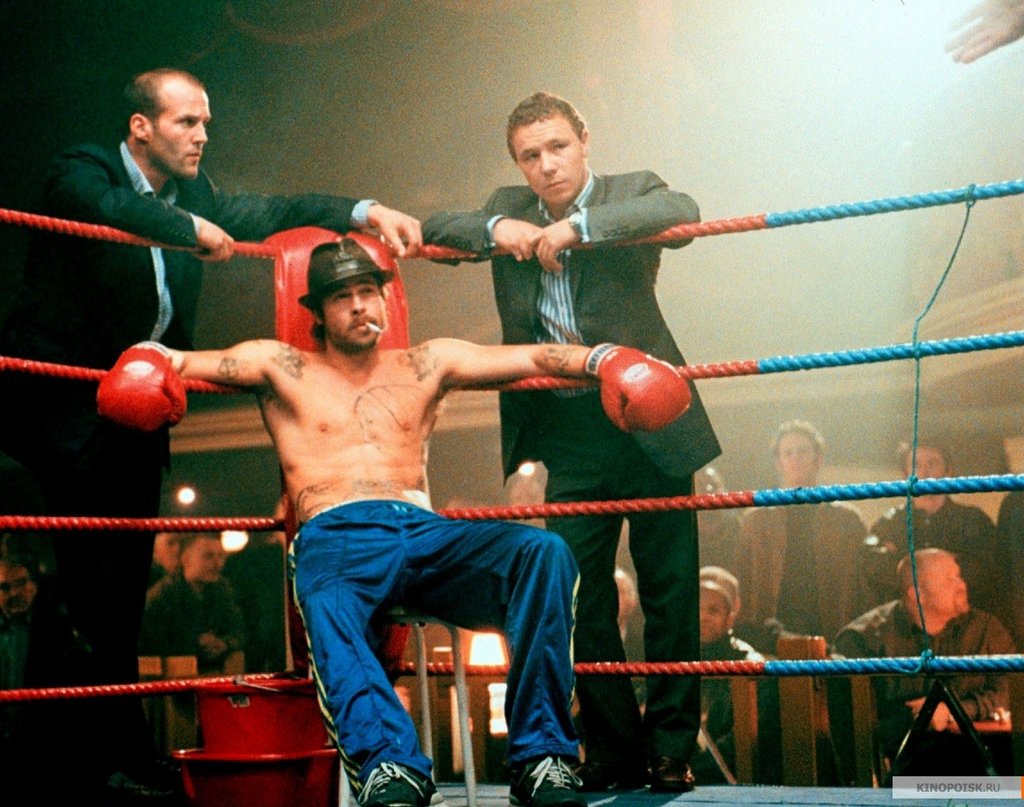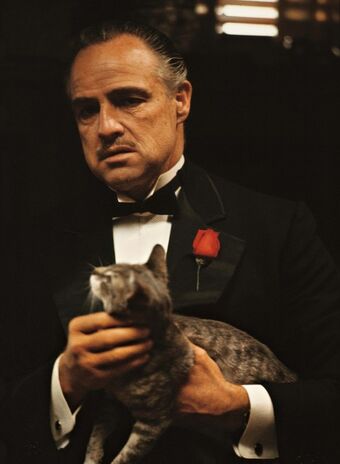
What do you get when you cross an unlicensed boxing match, a gang of angry gypsies and an 86-carat diamond that everybody wants to get their hands on? Guy Ritchie’s Snatch.[i] The film revolves around the adventures of:
Turkish (Jason Statham)and his sidekick Tommy (Stephen Graham): two boxing promoters tasked with finding a boxer for the fight, whilst trying their best to stay alive.
Brick Top (Alan Ford): local gangster who keeps a collection of man-eating pigs.
Mickey (Brad Pitt): short-tempered bare-knuckle boxing champion who doesn’t like being told what to do.
Franky Four Fingers (Benicio Del Toro): jewel thief and gambling addict who gets distracted when selling the diamond.
Bullet Tooth Tony (Vinnie Jones): thug hired to track down the missing Franky.
Boris the Blade (Rade Šerbedžija): Russian criminal in pursuit of the diamond.
Vinny (Robbie Gee) and Sol (Lennie James): pawn brokers hired by Boris to steal the diamond from Franky.
A comedy of errors sees the diamond change hands several times before being swallowed by a dog in this fast-paced gangster flick full of twists and turns, with animals having a starring role throughout.


Snatch is a crime comedy; a genre that accommodates stories revolving around the lives of criminals, whilst adding a humour that generally occurs as a result of the ‘incompetence of the characters’.[ii] Guy Ritchie has become famous for producing films in this genre, claiming, “It was a market which I thought had not been exploited.”[iii] Despite coming from ‘roots in a far more elevated social strata’,[iv] as satirised by Lydia Millet,[v] who spoke of his ‘faux-cockney stylings’ on his ‘thousand acre’ property, Ritchie feels that the genre has “lent itself to (his) sort of personality.”[vi]
Often described as ‘mockneys’,[vii] Ritchie’s films in the crime comedy genre began with Lock, Stock and Two Smoking Barrels,[viii] which is described as a ‘moral story, but it finds a rich seam of black humour in its characters failings’.[ix] Snatch is almost ‘identically toned’,[x] with humour developing from the uselessness of the criminals, most notably when the diamond is swallowed by the dog. Despite the slapstick elements, Snatch is loyal to its gangster roots, with intimidating villains such as Brick Top providing the antagonist. The use of animals is prevalent throughout this framework, particularly the overuse of pigs as a means for disposing of bodies, which contributes to the crime element of the genre.
The positioning of pigs in Snatch is intriguing, as Brick Top unnaturally uses them as a threat. At the beginning of the film, Brick Top tells Errol to “Feed them to the pigs,” in reference to two characters he’s had disagreements with. He says it with a smile on his face, which positions the audience to assume that it is said light-heartedly. However, in the following scene Brick Top is walking with Turkish and Tommy past various pens containing pigs, as he throws them food out of a bag. Pigs are generally considered to be harmless and innocent in real life, but this immediately attaches negative connotations to them, as we now view pigs as a source of violence. In cultural representations, pigs are often portrayed in a violent way, as the common trope of being fed to pigs is explored in the novel[xi] and adaptation of Hannibal.[xii] The use of pigs as a source of violence effectively makes the audience uncomfortable, as it highlights “humanity’s primal fear of being eaten”,[xiii] as well as the idea of ‘role reversal’, in the sense that humans eat pigs and this scenario turns that idea on it’s head to portray humans as vulnerable.
The use of pigs as a threat is heightened during a scene in which Turkish is trying to avoid Brick Top, and is greeted by Errol saying “Oink oink.” Generally this wouldn’t seem to have any significance to violence, but the association that has been made about pigs previously makes the audience aware that Turkish is in danger. This situation contributes to the crime comedy genre, as whilst Errol is making a threat in what is obviously a tense moment in the film, an adult making animal noises is considered childish and immature. The light-hearted, humorous portrayal of this serious part of the film makes the audience hopeful that Turkish can get out of the situation, when previously they would have feared for him.
The use of ‘oink oink’ may also refer to the traditional nickname of ‘pig’ for policemen. There’s a connotation here that the pig imagery throughout the film essentially means ‘you’ve been caught doing something wrong and you’re going to be punished’, reminiscent of the justice system. There’s an irony here of gangster characters using police as a subtle threat, which further relates to the genre, as the irony is ridiculous yet works as a threat due to the power and intimidation of the characters.
Later on in the film, Brick Top explains the best way to get rid of a dead body, which is to feed them to pigs.
Not only does this continue to highlight the negative connotations that have become associated with pigs, but it also ties into common themes in terms of the ‘crime comedy’ genre. The crime aspect is clear, as it is an incredibly vivid description of how to dispose of a dead body and is reminiscent of a traditional Hollywood gangster film. The speech is concluded with, “Hence the expression, as greedy as a pig,” which provides a comedic aspect to the situation, as we remain unsure whether Brick Top is being sarcastic or genuinely believes that murderers coined the phrase.
The isolated idea of a man in a room explaining to a group of strangers how to feed a body to pigs is sadistic, yet humorous as Brick Top delivers it in a cavalier, everyday approach, sitting down with his legs crossed and drinking a cup of tea, as if it is just a regular conversation. By portraying Brick Top in this way, Ritchie is attempting to make the character seem somewhat delusional and as though he has to be correct about everything, which is a foreshadowing to the end of the film when Mickey double crosses him and has him killed. The consistent emphasis on the word ‘greedy’ is a reference to Brick Top’s character and how his greed for money and power turned to arrogance, making him vulnerable.
Whilst pigs are portrayed in a threatening way throughout the film, dogs are shown to be loyal and affectionate, although they remain just as relevant to the framework. Before the dog swallows the diamond for real, Bullet Tooth Tony and Cousin Avi mistakenly think that it has already done so, which leads to a moral dilemma. Cousin Avi says, “Look in the dog. Open him up,” to which Bullet Tooth Tony replies, “He’s not a tin of fucking baked beans, what do you mean open him up?” This interchange provides a comedic irony, which reflects the ‘crime comedy’ genre. Bullet Tooth Tony has spent the entire film threatening, torturing and murdering people, seemingly without any of it bothering him in the slightest, but automatically decides he has a conscience when it comes to harming an animal. This sequence pokes fun at traditional gangster films, where criminals have no moral compass when it comes to harming people that have wronged them, but are caring when it comes to animals, such as Vito Corleone and his cat in The Godfather.[xiv] Ritchie shows that the hard, intimidating gangster characters have a caring side to them, which shows a flaw to their personality and highlights vulnerability. It pokes fun at traditional gangster characters by highlighting the illogical nature of this unpredictable moral compass, showing that it is a short sighted opinion to believe that we can pick and choose when we can show empathy.

Bullet Tooth Tony’s revelation that he doesn’t want to hurt the dog is a stark contrast to other characters in the film who generally see animals as disposable, most notably when Sol reveals that he was given the dog in the first place by the gypsies as part of a deal, portraying animals as exchangeable commodities. Vinny gives the dog a squeaky toy to keep him quiet, which has the face of a pig on it. The violent connotations of the pig are relevant as the pig is being used to ‘shut up’ the dog, however the dog ironically swallows the squeaky toy, which causes it to make even more noise than before. This situation can be related to the main antagonist, Brick Top, as he also uses pigs to silence people, but it doesn’t always work, as shown at the end of the film when Mickey gets his revenge by winning the fight he was supposed to lose and then having Brick Top killed. Like Brick Top, this situation is absurd and ridiculous, which provides elements of humour alongside undertones of violence, which contributes to the philosophy of the comedy crime genre.
The portrayal of pigs is important, as it forces the audience to consider pigs in a different way than they may have needed to before. Attaching violent connotations to pigs not only shows them as a threat throughout the film, but also makes the viewer consider everyday life, even if sardonically, as Brick Top warns us to “be wary of any man who keeps a pig farm.” Brick Top is implying here that pig farmers are violent murderers. This sweeping generalisation contributes to the farcical nature of the character’s personality, as it provokes a ridiculous image that provokes humour, with veiled connotations of violence. The use of pigs as a threatening device is unique and also brings a fresh element of danger to the experience. Although there are guns, other weapons and murders spread throughout the film, fans of this genre will have become desensitised to these to an extent, as they are so common in crime films, so the pig element provides us with a new idea to be worried about in terms of the safety of the characters.
In terms of other animal films, one film that shares similarities with Snatch is The Bear,[xv] notably in relation to applying violent connotations to generally innocent animals. In The Bear, the main bear is being pursued by a couple of hunters, accompanied by a pack of dogs. Dogs are animals that we deal with in society every day, and they are generally friendly and happy, however this film portrays them as aggressive hunters, whilst simultaneously positioning the traditionally malicious bear as vulnerable. The dogs are shown constantly growling and showing their teeth, whilst every time they bark in the film it is associated with violence and danger, evoking sympathy for the bear that is being hunted. This portrayal of dogs relates to the use of pigs in Snatch, as it provides an innocent animal with violent stereotypes, causing the audience to view the animal in a different way than they would regularly. These representations of animals relate to issues of animalisation explored by H.G Wells in The Island of Doctor Moreau.[xvi] Animals are brutalised and represent the malicious intentions of humans in the form of an animal. The dogs in The Bear are assigned with the vicious mentality of the hunters, whilst the pigs are representations of Brick Top’s aggression. Portraying them in an unusual way is unnatural to their reputation in real life, so we as an audience see them as separate from our ideas of dogs and pigs, which isolates these animalised versions and allows us to separate them from reality and highlight their comparisons.
Bibliography
1) Annaud, Jean-Jacques, The Bear (France: TriStar Pictures, 1988)
2) BBC, ‘Films – Interview – Guy Ritchie – Snatch’, BBC<https://www.bbc.co.uk/films/2000/07/10/guy_ritchie_1_interview.shtml> [accessed 25 November 2015]
3) Coppola, Francis Ford, The Godfather (United States: Paramount Pictures, 1972)
4) ‘Crime Film’, Wikipedia (Wikimedia Foundation, 2015) <https://en.wikipedia.org/wiki/Crime_film> [accessed 25 November 2015]
5) ‘Fed to Pigs’ <https://tvtropes.org/pmwiki/pmwiki.php/Main/FedToPigs> [accessed 30 December 2015]
6) ‘Guy Ritchie: From Geezer to Crowd-Pleaser’, The Telegraph (The Telegraph, 8 August 2015) <https://www.telegraph.co.uk/film/the-man-from-uncle/guy-ritchie-career-movies/> [accessed 25 November 2015]
7) Harris, Thomas, Hannibal: (Hannibal Lecter) (United Kingdom: Arrow Books, 2009)
8) Ritchie, Guy, Lock, Stock and Two Smoking Barrels (United Kingdom: PolyGram Filmed Entertainment, 1998)
9) Ritchie, Guy, Snatch (United Kingdom: Columbia Pictures, 2000)
10) Scott, Ridley, Hannibal (USA: Metro-Golydwyn-Mayer, 2001)
11) ‘Sexing the Pheasant’, in Love in Infant Monkeys, by Lydia Millet (Berkeley, CA: Shoemaker & Hoard, Div of Avalon Publishing Group, 2009)
12) Thomas, Liz, ‘Guy Ritchie, the Mockney with a King in the Family’,Daily Mail (Daily Mail, 21 October 2009) <https://www.dailymail.co.uk/tvshowbiz/article-1221860/Guy-Ritchie-mockney-king-family.html> [accessed 30 December 2015]
13) Wells, H. G., The Island of Doctor Moreau (United States: Wildside Press, 2004)
[i]Guy Ritchie, Snatch (United Kingdom: Columbia Pictures, 2000).
[ii]‘Crime Film’, Wikipedia (Wikimedia Foundation, 2015) <https://en.wikipedia.org/wiki/Crime_film> [accessed 25 November 2015].
[iii]BBC, ‘Films – Interview – Guy Ritchie – Snatch’, BBC<https://www.bbc.co.uk/films/2000/07/10/guy_ritchie_1_interview.shtml> [accessed 25 November 2015].
[iv]‘Guy Ritchie: From Geezer to Crowd-Pleaser’, The Telegraph(The Telegraph, 8 August 2015) <https://www.telegraph.co.uk/film/the-man-from-uncle/guy-ritchie-career-movies/> [accessed 25 November 2015].
[v]‘Sexing the Pheasant’, in Love in Infant Monkeys, by Lydia Millet (Berkeley, CA: Shoemaker & Hoard, Div of Avalon Publishing Group, 2009).
[vi]BBC, ‘Films – Interview – Guy Ritchie – Snatch’, BBC<https://www.bbc.co.uk/films/2000/07/10/guy_ritchie_1_interview.shtml> [accessed 25 November 2015].
[vii]Liz Thomas, ‘Guy Ritchie, the Mockney with a King in the Family’,Daily Mail (Daily Mail, 21 October 2009) <https://www.dailymail.co.uk/tvshowbiz/article-1221860/Guy-Ritchie-mockney-king-family.html> [accessed 30 December 2015].
[viii]Guy Ritchie, Lock, Stock and Two Smoking Barrels (United Kingdom: PolyGram Filmed Entertainment, 1998).
[ix]‘Guy Ritchie: From Geezer to Crowd-Pleaser’, The Telegraph(The Telegraph, 8 August 2015) <https://www.telegraph.co.uk/film/the-man-from-uncle/guy-ritchie-career-movies/> [accessed 25 November 2015].
[x]‘Guy Ritchie: From Geezer to Crowd-Pleaser’, The Telegraph(The Telegraph, 8 August 2015) <https://www.telegraph.co.uk/film/the-man-from-uncle/guy-ritchie-career-movies/> [accessed 25 November 2015].
[xi]Thomas Harris, Hannibal: (Hannibal Lecter) (United Kingdom: Arrow Books, 2009).
[xii]Ridley Scott, Hannibal (USA: Metro-Golydwyn-Mayer, 2001).
[xiii]‘Fed to Pigs’ <https://tvtropes.org/pmwiki/pmwiki.php/Main/FedToPigs> [accessed 30 December 2015].
[xiv]Francis Ford Coppola, The Godfather (United States: Paramount Pictures, 1972).
[xv]Jean-Jacques Annaud, The Bear (France: TriStar Pictures, 1988).
[xvi]H. G. Wells, The Island of Doctor Moreau (United States: Wildside Press, 2004).